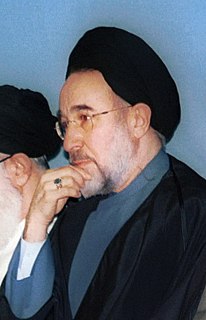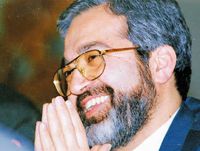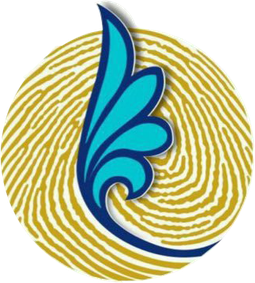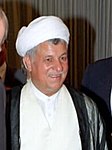
Akbar Hashemi Rafsanjani was an Iranian politician, writer, and one of the founding fathers of the Islamic Republic who was the fourth president of Iran from 1989 to 1997. He was the head of the Assembly of Experts from 2007 until 2011 when he decided not to nominate himself for the post. He was also the chairman of the Expediency Discernment Council.

The Reformists are a political faction in Iran. Iran's "reform era" is sometimes said to have lasted from 1997 to 2005—the length of President Mohammad Khatami's two terms in office. The Council for Coordinating the Reforms Front is the main umbrella organization and coalition within the movement; however, there are reformist groups not aligned with the council, such as the Reformists Front.

Presidential elections were held in Iran 17 June 2005, with a second round run-off on 24 June. Mohammad Khatami, the previous President of Iran, stepped down on 2 August 2005, after serving his maximum two consecutive four-year terms according to the Islamic Republic's constitution. The election led to the victory of Mahmoud Ahmadinejad, the hardline mayor of Tehran, with 19.48% of the votes in the first round and 61.69% in the second. Factors thought to have contributed to Ahmadinejad's victory include mobilization of mosque networks and conservative/hardline voters, and a protest vote against corrupt elite insiders and for "new political blood". A loyal supporter of conservative Supreme Leader Khamenei, Ahmadinejad kissed the leader's hand during his authorization ceremony. Officials reported a turnout of about 59% of Iran's 47 million eligible voters, a decline from the 63% turnout reported in the first round of balloting a week before.

The Alliance of Builders or Developers of Islamic Iran, usually shortened to Abadgaran, was an Iranian conservative political federation of parties and organizations. Described as "Iran's neocons", main groups within the alliance were Front of Followers of the Line of the Imam and the Leader members and Society of Devotees of the Islamic Revolution.

Presidential elections were held in Iran on 23 May 1997, which resulted in an unpredicted win for the reformist candidate Mohammad Khatami. The election was notable not only for the lopsided majority of the winner - 70% - but for the high turnout. 80% of those eligible to vote did so, compared to 50% in the previous presidential election.
Presidential elections were held in Iran on 24 July 1981 after the previous Iranian president, Abolhassan Banisadr, was impeached by the Majlis on 21 June and then sacked by the Supreme Leader, Ayatollah Khomeini, on 22 June. The elections occurred after the Hafte Tir bombing, which killed Mohammad Beheshti and dozens of other Iranian officials on 28 June 1981. This led to the election of Mohammad Ali Rajai, the previous prime minister, winning 13,001,761 votes out of the 14,573,803 votes cast, which was 89% of the votes. The vote turnout was 65.29%.

Seyed Mohsen Nourbakhsh was an Iranian economist, most known as governor of the Central Bank of Iran and the former minister of finance of Iran. Nourbakhsh had pro-market views.

The fourth Iranian Assembly of Experts election was held on 15 December 2006. The Assembly of Experts is a Council of 86 mujtahids that elect the Supreme Leader, and oversee his actions. The members of the Assembly are elected every eight years directly by the people of Iran.
Iranian City and Village Councils elections, 2003 took place in February 2003, the second time local elections for city and village councils had taken place since being introduced in 1999, and 905 city and 34,205 village councils were up for election.

Legislative elections for Majlis of Iran were held on 14 March 2008, with a second round held on 25 April 2008. Conservatives loyal to President Mahmoud Ahmadinejad were considered the victors of the election, at least in part because "all the most prominent" reformist candidates were disqualified from running.

Akbar Torkan was an Iranian mechanical engineer and politician, who was the President Hassan Rouhani's chief adviser from 2013 to 2018. He served as the CEO of Iran's Construction Engineering Organization from 2014 to 2017. He was also the Minister of Defense and Minister of Roads and Transportation in the government headed by President Akbar Hashemi Rafsanjani.
Premiership of Mir-Hossein Mousavi were the third and fourth government of Iran after the Iranian Revolution. At that time, Ali Khamenei was the president.
Front for the Liberation of Iran (FIL), Iran Liberation Front (ILF) or the Saviour Front was an Iranian monarchist organization based in Paris, which sought to restore the Pahlavi dynasty following the Iranian Revolution. It was led by Ali Amini, former Prime Minister of Iran, who announced establishment of the group on 19 January 1982.
A constitutional referendum was held in Iran on 2 and 3 December 1979. The new Islamic constitution was approved by 99.5% of voters.

Mohammad Saeedikia is an Iranian politician who is the former head of Bonyad-e Mostazafen va Janbazan, from 2014 to 2019. He served as a government minister in different cabinets last of which was minister of housing and urban development from 2005 to 2009.

Parliamentary elections were held in Iran on 26 February 2016 to elect members of the Islamic Consultative Assembly for all seats in the 10th parliament in the Islamic Republic era and the 34th since the Persian Constitutional Revolution. A second round was held on 29 April 2016 for some constituencies where candidates failed to obtain the required minimum 25 percent of votes cast. The elected MPs served from 28 May 2016 to 27 May 2020.

In the 1989 Iranian Supreme Leader election the Assembly of Experts members voted to choose the second Supreme Leader of Iran. The election was held on June 4, 1989, the morning after Ruhollah Khomeini's death and Ali Khamenei was elected as his successor with 60 votes out of 74.

Pervasive Coalition of Reformists: The Second Step, named The List of Hope by Mohammad Khatami, was the sole coalition and electoral list affiliated with the Iranian reform movement for the 2016 legislative election. The group also endorsed candidates for the 2016 Assembly of Experts election. Reformists backed a list of 236 candidates for the Parliament and 77 for the Assembly of Experts, even though many of them are not reformists but moderate-leaning figures.

The Government of the Islamic Republic of Iran is the ruling state and current political system in Iran, in power since the Islamic revolution and fall of the Pahlavi dynasty in 1979.
An election to the Islamic City Council of Tehran took place on 28 February 2003, along with the local elections nationwide.















